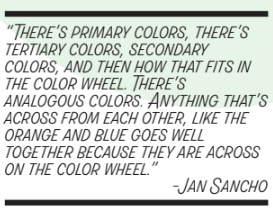Are you a warm winter? Or maybe a cool spring? The viral TikTok filter has been making its rounds on For You pages, promising to show users what their perfect color season is.
Julia Dobkine, a color and style consultant, as reported by Today, defined a color season as being a “color palette based on their natural undertones, whether they’re cool, warm, [etc].”
Dobkine posts videos on her TikTok page using cloth drapes for each person wanting a consultation. She advises each person to come with no makeup, wearing just white clothing. This allows for her to have a neutral base to compare the colored drapes to.
She then goes through the drapes, showing which colors “wash out” her client and which don’t. This is done by picking the colors that bring out the client’s undertones.
Color analysis is deeply rooted in color theory. VHHS art teacher, Allison Molloy, explains that one aspect of color theory examines how warm colors and cool colors interact with each other.
“If I am wearing a warm hoodie over a cool shirt, that might be a nice compliment because the warm would push forward while the cool would push back.” Molloy said.
Career & Technical Education Teacher, Jan Sancho teaches color theory to her Style studio using a color wheel.
“There’s primary colors, there’s tertiary colors, secondary colors, and then how that fits in the color wheel. There’s analogous colors. Anything that’s across from each other, like the orange and blue goes well together because they are across on the color wheel,” said Sancho.

While being interviewed, Molloy wore a red and black checkered shirt, a choice influenced both by her undertones and the idea that warm colors are best accompanied with cooler colors or neutral tones.
“For example, I am a very light caucasian person, but I have a lot of pink in my skin and a lot of blue because I am thin. If you look at your own hand, you can see a lot of colors that are in your own body and that show,” said Molloy.
Nitay Patel (12), a student researching the impacts of color in photography, explained the importance of using color theory in clothing.
“I’d say [it’s important for] first impressions. If you use color theory, it helps a lot on first impressions. Like for a job interview, for example,” Patel said.
Sancho uses weather as a determining factor in which colors she personally chooses to wear.
“I always think about the weather. It plays a big part. The other day, it was really nice and warm, so I thought about spring. I knew it was going to be nice outside, so that’s how I chose yellow to wear. That’s how I was feeling, and that is what I was excited to wear. In the winter, I go for the darker colors, because that’s what matches the season,” Sancho said.
Patel advised people to experiment with their existing clothes.
“Try out whatever you can with your wardrobe, with clothes you have currently,” Patel said.
Molloy advised people to test out the clothes they already have in different lighting to see which ones match their color palette the best.
“[You should see] different photos of you in different lighting situations, like…under lamplight at home, outside on a sunny day, outside on a cloudy day, and in school fluorescent lights,” Molloy said.
Similarly, both Patel and Sancho suggested that people play around with colors to see which ones ultimately look most flattering.
“I think [everyone should] play around with their colors. I know sometimes people don’t like the look of [certain colors]…. You just want to know how to style it,” Sancho said.
